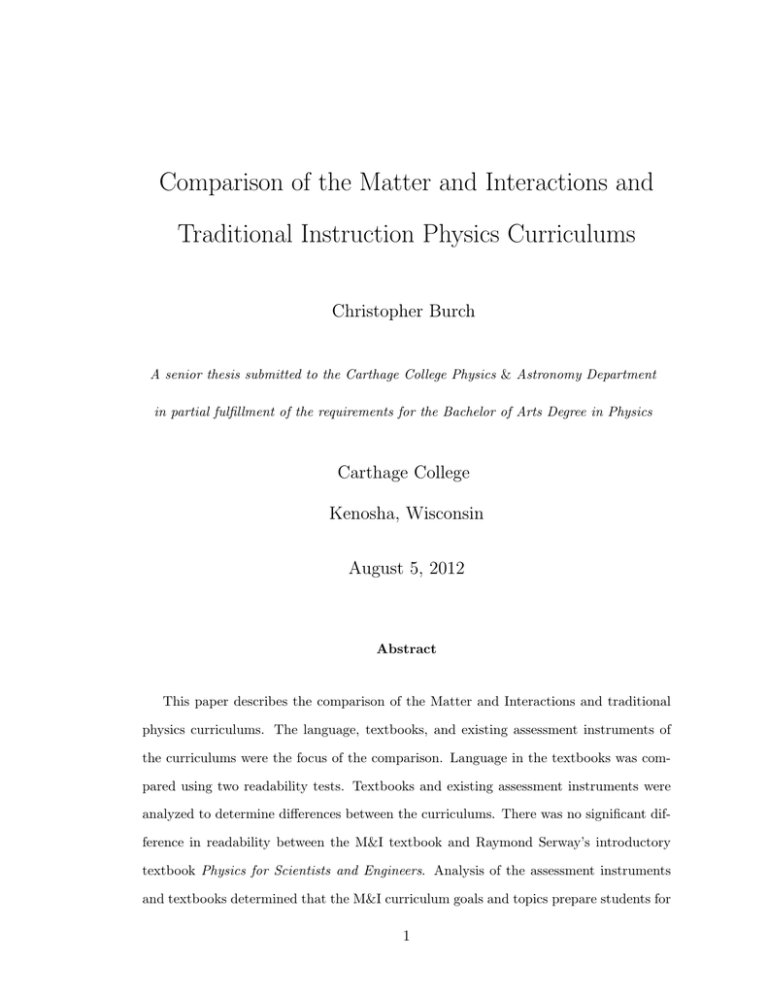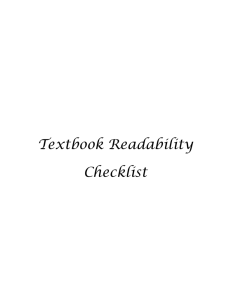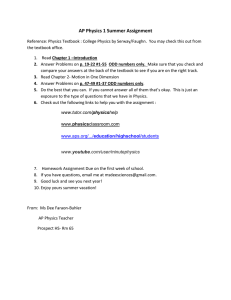cburch-thesis 5-5.15.12
advertisement

Comparison of the Matter and Interactions and Traditional Instruction Physics Curriculums Christopher Burch A senior thesis submitted to the Carthage College Physics & Astronomy Department in partial fulfillment of the requirements for the Bachelor of Arts Degree in Physics Carthage College Kenosha, Wisconsin August 5, 2012 Abstract This paper describes the comparison of the Matter and Interactions and traditional physics curriculums. The language, textbooks, and existing assessment instruments of the curriculums were the focus of the comparison. Language in the textbooks was compared using two readability tests. Textbooks and existing assessment instruments were analyzed to determine differences between the curriculums. There was no significant difference in readability between the M&I textbook and Raymond Serway’s introductory textbook Physics for Scientists and Engineers. Analysis of the assessment instruments and textbooks determined that the M&I curriculum goals and topics prepare students for 1 further education in physics, whereas Serway’s textbook and curriculum better prepares students for other fields in science and engineering. 1 Introduction Traditionally, physics education research (PER) has been centered on student misconceptions and their tendency to impede learning. The principle message from PER has been the necessity of identifying student misconceptions upon entering physics classrooms and then providing an instructional intervention to eliminate misconceptions.[1] In more recent years work in PER has become diversified to consider additional contributions to learning, such as conceptual understanding, epistemology, problem solving, attitudes, technology, and instructional materials.[2] Research on misconceptions now has become one facet of investigating into conceptual understanding. The epistemology category covers research and theories on cognition in the physics classroom. Problem solving involved studies both on how experts solve physics problems as well as how novices develop problem-solving abilities. Many studies on attitudes have found that students attitudes degrade throughout a physics course and current research on the subject concentrates on how to maintain and improve attitudes throughout those courses. The use of technology in instruction has been explored through programs such as WebAssign, published online recourses like Mastering Physics, PHETs, Kahn academy, and others. Various instructional materials have also been studied and developed through research, including JITT, Peer Instruction, and on a broader scale, the Matter and Interactions curriculum.[2] In performing PER conceptual understanding, problem solving, and attitudes, the first task is to articulate a question related to the learning and teaching of physics, and the second is to develop assessment instruments that address the question. Problem solving is a major focal point of PER, and a principle investigation approach is the degree of expertise assessments 2 used to show problem generalization techniques such as the ability to recognize key physical concepts in a given problem.[3] Extensive research, design, and validation have been implemented in the field of conceptual standardized tests such as the Force Concepts Inventory (FCI) and the Energy and Momentum Conceptual Survey (EMCS).[4] The FCI targets common misconceptions students have related to force and motion, whereas the EMCS focuses on energy misconceptions.[1][5] While the listed assessment instruments are research validated, they do not give reliable results outside of the curriculum for which they were designed. For example, the FCI and FMCE are specifically designed for traditional physics instruction whereas the Matter and Interactions (M&I) curriculum takes an entirely different approach to the learning of physics; FCI and FMCE questions include distractor choices that focus on certain misconceptions that arise in the traditional curriculum. The M&I curriculum emphasizes physics concepts differently and has different course goals that make these misconception-based items less relevant for M&I students. As a result, the FCI will not give equally valid and reliable for both M&I students and traditional instruction students. Unfortunately, there are few assessment instruments designed for M&I curriculum due to the relatively recent development of the M&I curriculum. The Energy Concepts Assessment is currently the only instrument available designed to test concepts emphasized in the Matter and Interactions curriculum.[6] In order to develop an assessment instrument specific to M&I it is necessary to establish precisely how it differs from the traditional curriculum. According to the authors description the M&I curriculum focuses on a few key concepts and introduces physics as emerging from these principles rather than separate subtopics.[7] The curriculum also emphasizes the importance of starting all problem solving using fundamental principles (momentum principle, energy principle, and angular momentum principle).[8] The process of modeling a physical system is also considered important; in M&I students are tasked with constructing models, simplifying, analyzing, and using them to make estimations. The language structure 3 and word choice in problems from the textbook and instrument are also different in that they are designed to prompt the use of physics principles. Showing the limitations of classical mechanics (relativistic corrections, quantized energy, ect.) is one of the core goals of the M&I curriculum, as well. All of the listed concepts differ from those emphasized in a traditional instruction-based course, and questions that probe these differences must be integrated into any M&I assessment instrument. The first step to creating such an instrument involves recognizing these differences by comparing the M&I textbook and assessment instrument to a traditional physics instruction textbook and instrument that cover the same concepts. This information can then be used to construct questions that address the differences between curriculums. 2 Analysis of Textbooks The complexity of the language involved in the textbook can be a major discriminating factor between curriculums. Complexity of language is measured through readability tests. Both the Gunning-Fog index and the Flesch-Kincaid Grade Level Formula are examples of readability tests.[9] The Gunning-Fog index formula compares the number of words per sentence and the number of complex words (3 syllables or more) to total number of words. The Flesch-Kincaid Grade Level Formula is slightly differs, comparing the total number of words to the total number of sentences, and the total number of syllables to the total number of words. The scores of the tests are intended to determine the difficultly of comprehension for a passage. For example, a textbook with a Gunning-Fog index or Flesch-Kincaid grade level of 20 would be more difficult to comprehend than one with an index or grade level of 15. The textbook with the score of 20 may not be appropriate for the course if it is intended for freshmen and sophomores in college. Differences in the estimated grade level of language, known as readability, between textbooks are a result of the differences between curriculums 4 and their intended audience. No significant readability difference was found in the energy chapters between the M&I textbook and Raymond Serways Physics for Scientists and Engineers (Figure 1). Using an 800-word sample from the beginning of each textbooks introduction to energy chapter, M&I was found to have readability scores of 13.85±2.94 (Gunning-Fog index) and 11.04±2.89 (Flesch-Kincaid Grade Level Formula). Using the same sampling, Serways textbook was found to have readability scores of 14.76±4.03 (Gunning-Fog index) and 11.95±3.67 (FleschKincaid Grade Level Formula). Since the readability scores of M&I and Serway are similar, the language complexity does not factor into the differences between the curriculums and textbooks. Figure 1: A sample readability comparison between the M&I introductory energy chapter and Serway’s introductory energy chapter. 3 Analysis of Concept Tests The questions from the M&I Energy Test differ from the EMCS questions in that they involve single principles or concepts (Table 1). Most of the questions can be directly linked 5 to a single section throughout the energy chapters, and many of the sections are represented. Even further, many problems can be directly solved using methods and representations from their specific section. Item 1 2 3 4 5 6 7 8 9 10 M & I Energy Test Relativistic Kinetic Energy (EP) Rest Mass Energy (EP) Energy as a Scalar Energy as a Scalar Kinetic Energy Electric Potential Energy (EP) Gravitational Potential Energy Gravitational Potential Energy Electric Potential Energy (EP) Spring Potential Energy EMCS Gravitational Potential Energy, Work Gravitational Potential Energy and Kinetic Energy (PI) Elastic Collision, Conservation of Momentum Gravitational Potential Energy, Energy as a Scalar (PI) Conservation of Momentum, Elastic and Inelastic Collisions (T) Conservation of Energy, Gravitational Potential Energy Conservation of Momentum (T) Tension Force, Work Conservation of Energy Energy as a Scalar (T) Table 1: The concepts involved in the first 10 questions of each concept test. The EMCS questions often contain several linked concepts in a single question, whereas the M&I Energy Test questions involve a single concept or principle. (EP) = Elementary Particles (PI) = Path Independence (T) = Technology-based Surface Features One example shows how the M&I Energy Test items are derived from M&I textbook representations of concepts. Question 10 is a potential energy problem that is represented by springs. Spring potential energy situations are introduced in Chapter 6 Section 1 with an energy curve plotting potential energy as a function of the springs stretch (Figure 2). Since M&I students are introduced to this topic with this graph, they can relate the concepts of stretch and spring potential energy. Question 10 is a problem where one spring is compressed and another is stretched by the same distance. Given the springs have the same stiffness, the students have to recognize that there is no difference in spring potential energy as long as the compression distance is equal to the stretch distance. M&I students would be able to relate this concept to the energy curve and solve the problem given the original parabolic representation of spring potential energy. Whereas traditional assessment instruments do not cover the limits of classical mechanics, the first question of the M&I Energy Test involves a relativistic adjustment for the kinetic energy of an electron. Since it is a goal of the M&I curriculum, the limitations of classical mechanics are expressed in the instrument. While the adjustment is not quantitatively 6 Figure 2: Potential energy as a function of stretch s for an ideal spring, as presented in the M&I section on spring potential energy described in the answers, the key concept of the necessary adjustment is involved to check if students recognize the relativistic cases. Additionally, Question 2 relates rest mass energy to classical mechanics, as is covered in Chapter 5 Section 2. While the question only involves the definition of the rest mass energy, it still requires students to understand the relativistic concept of rest mass energy and how it connects the energy and momentum principles. The M&I textbook includes the quantum mechanics concept of quantized energy levels in Chapter 7. The M&I Energy Test also includes this concept in Questions 25 and 26 where it includes energy emission lines and ground state absorption spectrum. Both of these cases do not apply to classical mechanics due to the low energy levels and Serway briefly includes the topic in an optional section in Chapter 8, but M&I places a much greater emphasis on the topic by dedicating all of Chapter 7 to energy quantization. Sherwood chose to introduce energy quantization with classical mechanics energy concepts to show another limitation of classical mechanics, which leads to a complete and unified view of physics. While the relativistic and quantum examples convey the image of physics as a unified field by explaining how they align with classical mechanics, Questions 6, 9, and 31 do so by showing electricity and magnetism problems that parallel classical mechanics energy problems. Questions 6 and 9 are electric potential energy problems involving fundamental interactions. Question 6 requires the definition of electric potential energy to calculate the increase in 7 potential energy as the number of protons in a system increases. Question 9 requires applying electric potential energy concepts to determine where the potential energy is greatest along a path. Electric potential energy is a unique topic for a classical mechanics curriculum since it is typically omitted from traditional classical mechanics courses, and introduced in traditional electricity and magnetism courses. Serway does not include the topic until the third chapter of his E&M volume, which is the 25th chapter of his introductory physics series, whereas the M&I textbook first discusses it in Chapter 5 Section 13. While electric potential energy is not strictly a classical mechanics topic, its introduction in the energy chapters allows students to relate the energy between electric charges to the energy between macroscopic objects. This early comparison promotes a unified view of energy by allowing students to compare macroscopic objects to atomic particles through energy, rather than presenting them as separate, divided topics. Question 31 is also an E&M question but instead focuses on applying the definition of kinetic energy. The problem involves a moving electron that changes direction, but not speed, during an undisclosed time period. As a result, students are expected to recognize that the net force on the electron was nonzero, but the net work done on the electron was zero. This problem is an extension of Question 5, which requires students to recognize that a change in direction of a moving ball is a change in kinetic energy. While Question 31 involves work and net forces, it is the same as Question 5, but modified to include elementary particles to express the uniform application of the definition of kinetic energy. Apart from limitations and a unified view of physics, the M&I Energy Test does include two modeling problems. In Question 17, students are asked which system must be chosen if kinetic energy, spring potential energy, and gravitational potential energy are included. Question 18 gives students a system and then asks which types of energy apply to the system. Comparatively, the EMCS does not have any questions which involve modeling, and modeling is an unusual topic for assessment instruments. Despite this, the M&I Energy 8 Test includes these problems due to modelings emphasis in the M&I curriculum. 4 Discussion Given the analysis of the instrument, the M&I Energy Test does adhere to the M&I course goals that differ from the traditional physics curriculum. These differences do not necessarily create a more effective curriculum, but rather change the skills students develop throughout the semester. Students in the M&I curriculum are intended to develop skills and knowledge strongly related to the entire field of physics, whereas students in the traditional curriculum are intended to develop different types of problem solving skills as a result of the emphasis on force and motion. The M&I curriculum focuses on skills associated with the field of physics such as modeling, understanding and relating the branches of physics, and the use of fundamental principles as a basis for problem solving. While these skills are useful in the field of physics, they are inherently limited in other fields such as chemistry, biology, and even engineering. Students studying these other fields have little use for equations including relativistic adjustments, but will likely find additional time spent on force and motion problem solving to be more valuable. At the same time, traditional instruction students will likely find circular motion applications of Newtons law to fit into its own category, as is the case in Serway, and problem solving skills will develop accordingly. M&I students learn circular motion problems at the same time as other problems using the same fundamental principles, and thus develop different problem solving skills that are based on principles rather than relating them to surface features. The same can be said for modeling and just about any other difference between the curriculums; the curriculum goals, textbooks, and assessment instruments indicate that the M&I curriculum develops skills and tools that provide a stronger background for future education in physics, whereas the traditional physics curriculum accommodates a much 9 broader audience, excluding topics and course goals that are not necessarily functional in other fields, while both convey the information and concepts at the same readability level. 5 Summary and Future Design The goal of this study was to develop a basis for a future M&I assessment instrument by comparing the differences between the M&I and traditional instruction curriculums. Assessment instrument are not equally valid for for all curriculums because they are based on curriculum goals. Consequently, assessment instruments must be developed so that curriculum goals and language are emphasized; comparing the M&I curriculum to the traditional physics curriculum provides a strong basis for determining the focus of the M&I curriculum. The two curriculums were compared using readability tests, textbook analysis, and analysis of existing assessment instruments for both curriculums. Using the Gunning-Fog index and the Flesch-Kincaid Grade Level Formula, no significant difference was found in terms of readability between the M&I textbook and Serway’s introductory physics textbook. However, the analysis of the textbooks and assessment instruments resulted in several clear differences, all of which relate to the M&I course goals. These course goals directly affect the skills the students learn throughout the course. The M&I curriculum develops skills that provide a stronger background for future education in physics, whereas the traditional physics curriculum focuses on skills also used by engineers and other scientists. References [1] Hestenes, David, Malcolm Wells, and Gregg Swackhamer. ”Force Concept Inventory.” The Physics Teacher 30 (March 1992): 141-58. 10 [2] Beichner, Robert. An Introduction to Physics Education Research. Raleigh, NC: North Carolina State University, 29 Apr. 2009. [3] Chi, Michelene T. H., Paul J. Feltovich, and Robert Glaser. ”Categorization and Representation of Physics Problems by Experts and Novices.” Cognitive Science 5.2 (1981): 121-52. [4] Libarkin, Julie. Concept Inventories in Higher Education Science. 2008. MS. National Research Council Promising Practices in Undergraduate, Washington, D.C. [5] Singh, Chandralekha, and David Rosengrant. ”Multiple-choice Test of Energy and Momentum Concepts.” American Journal of Physics 71.6 (2003): 607-17 [6] Adams, Wendy K., Katherine K. Perkins, Michael Dubson, Noah D. Finkelstein, and Carl E. Wieman. ”The Design and Validation of the Colorado Learning Attitudes about Science Survey.” PER Conference Series 790 (2004): 45-48. [7] Chabay, Ruth, and Bruce Sherwood. ”Bringing atoms into first-year physics.” American Journal of Physics 67 (1999): pp.1045-1050. [8] Chabay, Ruth and Bruce Sherwood. ”Modern Mechanics.” American Journal of Physics, 72 (2004): pp. 439-445. [9] http://www.online-utility.org/english/readability test and improve.jsp 11

